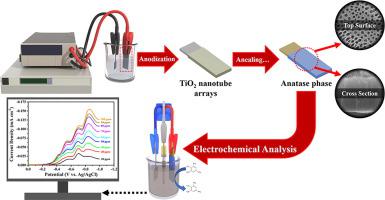Journal of Electroanalytical Chemistry ( IF 4.5 ) Pub Date : 2021-09-20 , DOI: 10.1016/j.jelechem.2021.115717 Sanghyeon Moon 1 , Devarayapalli Kamakshaiah Charyulu 2 , Wonjoo Lee 3 , Kiyoung Lee 1

|
In this study, we investigated how the geometric design of anodic one-dimensional (1D) TiO2 nanotube arrays affected their performance in the electrochemical reduction of 2,4,6-trinitrotoluene (2,4,6-TNT) in aqueous solutions and ambient conditions. Two main geometric parameters were considered: the inner diameter and length of TiO2 nanotubes. The various TiO2 nanotubes were fabricated using an anodization technique performed in four types of fluoride-containing organic solvents by adjusting various anodization parameters. All as-prepared samples successfully detected 2,4,6-TNT in an aqueous solution using cyclic voltammetry and linear sweep voltammetry. Three peaks corresponding to the reduction of each nitro group in 2,4,6-TNT were observed between − 0.5 and − 1.0 V (versus Ag/AgCl, 3 M KCl). Further, we discovered that nanotube length affected 2,4,6-TNT reduction performance. We also performed experiments at various concentrations of 2,4,6-TNT and determined the sensitivity to be 1.78 × 10-3 mA cm−2 ppm−1, the limit of detection to be 6.49 ppm, and the limit of quantitation to be 21.6 ppm 2,4,6-TNT over a linear range of 20 – 100 ppm using an electrode with nanotube inner diameter of 75 nm and length of 6 µm. A simple and fast fabricated composite-free 1D TiO2 nanotube arrays electrode can form the basis for future studies in enhancing the detection sensitivity. Electrochemical detection of other nitro-based compounds, such as nitroglycerin, nitrocellulose, picric acid, and their mixtures, require further investigation.
中文翻译:

控制阳极一维二氧化钛纳米管的几何设计,用于在环境条件下电化学还原 2,4,6-三硝基甲苯
在这项研究中,我们研究了阳极一维 (1D) TiO 2纳米管阵列的几何设计如何影响其在水溶液中电化学还原 2,4,6-三硝基甲苯 (2,4,6-TNT) 和环境条件。考虑了两个主要几何参数:TiO 2纳米管的内径和长度。各种TiO 2通过调整各种阳极氧化参数,使用在四种含氟有机溶剂中进行的阳极氧化技术制造纳米管。所有制备的样品均使用循环伏安法和线性扫描伏安法成功检测到水溶液中的 2,4,6-TNT。在 - 0.5 和 - 1.0 V(相对于Ag/AgCl,3 M KCl)之间观察到三个对应于 2,4,6-TNT 中每个硝基还原的峰。此外,我们发现纳米管长度影响 2,4,6-TNT 还原性能。我们还对不同浓度的 2,4,6-TNT 进行了实验,确定灵敏度为 1.78 × 10 -3 mA cm -2 ppm -1,检测限为 6.49 ppm,定量限为 21.6 ppm 2,4,6-TNT,线性范围为 20 – 100 ppm,使用纳米管内径为 75 nm,长度为 6 µm 的电极. 一个简单的和快速的制造自由复合-1D的TiO 2纳米管阵列电极在增强检测灵敏度形成用于未来的研究的基础。其他硝基化合物的电化学检测,如硝酸甘油、硝化纤维素、苦味酸及其混合物,需要进一步研究。



























 京公网安备 11010802027423号
京公网安备 11010802027423号